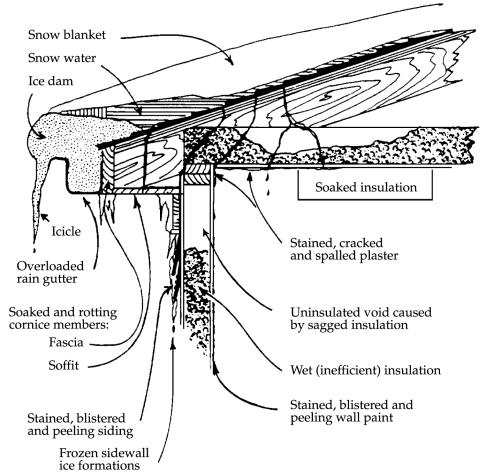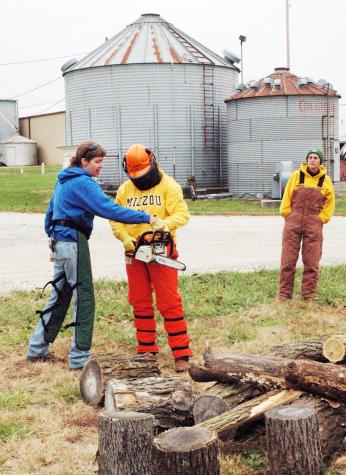
Species spotlight: White Oak
White oak (Quercus alba) is one of the preeminent hardwoods of eastern and central North America. It can be found from Minnesota, Ontario, Quebec, and Nova Scotia south as far as northern Florida and eastern Texas.Q. alba typically reaches heights of 80 to 100 feet at maturity, and its canopy can become quite massive if growing in a wide-open space, such as a field.

Ice dams on the roof can damage your home
MARSHFIELD, Mo. – Unwanted icicles hanging from the roof overhang are a warning sign of ice dams, which can inflict considerable interior and exterior damage to your home. According to Bob Schultheis, retired University of Missouri Extension natural resource engineering specialist, nonuniform roof temperatures cause ice dams. “In the winter, when warm air inside the house leaks into the unheated attic, it creates warm areas on the…

Reduce your risk: Lyme disease
According to the U.S. Centers for Disease Control and Prevention (CDC) and the American Lyme Diseases Foundation, the chance of contracting Lyme disease (LD) in Missouri is rare. It’s also rare in Florida. But back in the summer of 2000, I beat those odds and ran into that rare tick carrying the disease. It was not fun.

Winter car care to keep your vehicle running through the cold
MARSHFIELD, Mo. – Winter weather is hard on cars and trucks, but a little preparation will keep vehicles running well throughout winter’s coldest days.

Good fences make good neighbors: Missouri's purple paint statute
The purple paint statute (Section 569.145 of the Revised Statutes of Missouri) allows Missouri landowners to mark trees or posts with purple paint as a warning to would-be trespassers. It fulfills the same function as a “no trespassing” sign, a fence, or telling someone not to come onto your property. Since they can’t be taken down, destroyed or stolen, purple paint marks are cheaper and more economical to maintain.

Reduce your risk: Protect your woodland from wildfire
Damages from wildland fires can be devastating to your forests and wildlife. A single wildfire during the wrong set of conditions can wipe out years of investment in your trees. Here are four ways you can become proactive in wildfire protection:

Woodland management: Stumpage vs. mill-delivered price
Discover the differences between stumpage and mill-delivered prices in timber sales. Learn key cost factors and strategies to maximize woodland profits.

Woodland management: Just say no to high-grading
Many forest and woodlot owners oftentimes learn too late that some forestry techniques can limit options for future benefits and enjoyment — both in the long run and short term. While well-planned timber harvesting can increase your benefits, high-grading and related practices should be avoided.

Woodland management: Shooting a double — Managing oaks for acorn and timber production
Manage oak woodlands for both acorn production and timber value with effective strategies to enhance wildlife habitat and economic returns.

Plentiful feed, good calf-price outlook support adding pounds after weaning
KIRKSVILLE, Mo. – Cow-calf herd owners can send more pounds of beef to market by feeding calves after weaning. It’s called backgrounding to prepare calves for the feedlot.Speaking at the Missouri Livestock Symposium in Kirksville, Dec. 2, Eric Bailey asked producers to think bigger.Adding more pounds to calves makes sense in Missouri with plentiful feed and forage. Bailey, a new University of Missouri Extension beef nutritionist, gives…

Good fences make good neighbors: Missouri’s optional fence law counties
As of May 2016, 19 Missouri counties had opted into the optional county fencing statute [Section 272.210 of the Revised Statutes of Missouri (RSMO) fencing statute]. These counties are Bates, Cedar, Clinton, Daviess, Gentry, Grundy, Harrison, Knox, Linn, Macon, Mercer, Newton, Putnam, Schuyler, Scotland, Shelby, Sullivan, St. Clair and Worth. So, what are the basic differences between the general and optional fencing statutes?

Good fences make good neighbors: Missouri’s general fence law
Time and Mother Nature (particularly over the past winter and spring) can wreak havoc on fence lines. If you are faced with repairing or replacing a boundary fence line, now is a good time to review Missouri’s current fencing and boundary laws, particularly if you are new to the Show-Me State.

Study shows danger of short grazing toxic-fescue pastures by cattle herds
COLUMBIA, Mo. – New forage research gives reason to not graze toxic fescue grass too short. The bottom 2 inches of infected grass holds highest levels of the alkaloid causing problems for grazing livestock. The findings guide ways to manage fescue’s toxic impact, says Craig Roberts, University of Missouri Extension forage specialist. The message for herd owners: Don’t allow cows to grub fescue pastures into the ground.

Reduce your risk: Chain saw safety
Learn key chainsaw safety tips and maintenance steps to prevent accidents and keep your equipment in top condition.

Reduce your risk: Landowner liability
Learn how to manage landowner liability risks, including verifying insurance coverage, posting warnings, and removing hazards to protect your property.

Good fences make good neighbors: Livestock trespass
The liability of the livestock owner depends on whether the animals crossed an exterior or a division fence. An exterior fence is one that is not within a common enclosure. A fence along a public highway is an exterior fence. Division fences, on the other hand, are fences that separate adjoining landowners.

Good fences make good neighbors: Boundary line disputes
Boundary location disputes usually arise in connection with rebuilding or relocating old fences. The principle referred to as squatter’s rights, properly called the doctrine of adverse possession, then becomes important. This legal doctrine provides that someone in possession of land continuously for a period of 10 years may receive absolute title to the land if his or her possession was adverse to the interests of the true owner. The…

Chain saw chaps, protective gear help woodcutters avoid injury
COLUMBIA, Mo. – If you are looking for a holiday gift for anyone who owns a chain saw, consider chain saw safety chaps, said University of Missouri Extension horticulture specialist and woodcutter Katie Kammler. "A $100 pair of chain saw chaps is well worth it when you compare it to the cost of a hospital emergency room visit," Kammler said. Conventional jeans or pants do not protect against chain saw injuries.

Winterize roses in December
COLUMBIA, Mo.

Carefully select topsoil when doing fall yard work
COLUMBIA, Mo. – Not all topsoil is created equal.

Inexpensive soil tests can save farmers thousands
COLUMBIA, Mo. – Soil tests can save farmers thousands of dollars, says Manjula Nathan, director of the University of Missouri Soil and Plant Testing Laboratory. Too often, farmers follow routine fertilization schedules and end up applying too much fertilizer to fields, Nathan said. A simple soil test gives the farmer accurate information to guide nutrient management decisions.

MU Extension advises poultry and livestock producers of Nov. 15 emission filing deadline
COLUMBIA, Mo. – University of Missouri Extension specialist Teng Lim advises poultry and livestock producers to be aware of a Nov. 15 deadline that could affect their operations.

Landowner spotlight
A passionate woodland owner shares how decades of active forest thinning and invasive plant control boosted canopy, wildlife and timber value.